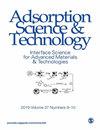玉米芯废液中氢氧化钠活化炭对玫瑰染料的强化吸附
IF 3.2
4区 工程技术
Q2 CHEMISTRY, APPLIED
引用次数: 0
摘要
生物质废弃物的水热炭化是制备经济实惠的活性烃类的一种潜在方法。本研究采用水热碳化玉米芯废弃物,然后用氢氧化钠(NaOH)活化制备氢炭。根据研究结果,在较长的保留时间、较低的液固比和较高的温度下产生的碳氢化合物的吸附能力要大得多。然后利用各种表征方法对水合物进行分析,并在各种条件下进行了涉及玫瑰红染料吸附的批量测试。结果表明,活化后的水合物比表面积为12.794 m2/g。为了更好地了解和表征染料在产物上的吸附过程、吸附动力学和吸附平衡,通过实验数据拟合进一步研究了吸附动力学和等温线。naoh活化的氢炭吸附量分别为799.9 mg/g。本研究的目的是评估从玉米芯中提取的氢氧化钠活化的碳氢化合物作为一种经济有效的吸附剂去除水溶液中的阴离子染料(如玫瑰红)的可行性。此外,该研究试图研究各种因素如何影响其吸附能力,并通过动力学和等温线分析提供对吸附过程的见解。本文章由计算机程序翻译,如有差异,请以英文原文为准。
Enhanced Adsorption of Rose Bengal Dye from Aqueous Solution Using NaOH Activated Hydrochar Derived from Corncob Waste
A potential approach to the preparation of affordable activated hydrochar is the hydrothermal carbonization of biomass wastes. In this study, hydrochar was made by hydrothermally carbonizing corncob wastes and then activating them with sodium hydroxide (NaOH). According to the findings, the adsorption capabilities of hydrochar generated at prolonged retention durations, lesser liquid-to-solid ratios, and elevated temperatures were considerably greater. The hydrochars were then analyzed utilizing a variety of characterization methods, and batch tests involving the sorption of rose bengal dye were carried out under a variety of conditions. According to the findings, activated hydrochar has a specific surface area of 12.794 m2/g. In order to better understand and characterize the process of rose bengal dye adsorption, sorption kinetics, and sorption equilibrium onto the produced hydrochars, sorption kinetics and isotherms were further examined through experimental data fitting. The NaOH-activated hydrochar’s adsorption capacity was 799.9 mg/g, respectively. The objective of this research was to assess the viability of using NaOH-activated hydrochar derived from corncobs as an economical and efficient sorbent for eliminating anionic dyes like rose bengal from aqueous solutions. Additionally, the study sought to investigate how various factors influence its sorption capabilities and to provide insights into the adsorption process through kinetic and isotherm analyses.
求助全文
通过发布文献求助,成功后即可免费获取论文全文。
去求助
来源期刊

Adsorption Science & Technology
工程技术-工程:化工
CiteScore
5.00
自引率
10.30%
发文量
181
审稿时长
4.5 months
期刊介绍:
Adsorption Science & Technology is a peer-reviewed, open access journal devoted to studies of adsorption and desorption phenomena, which publishes original research papers and critical review articles, with occasional special issues relating to particular topics and symposia.
 求助内容:
求助内容: 应助结果提醒方式:
应助结果提醒方式:


